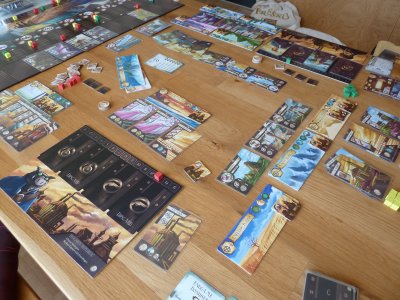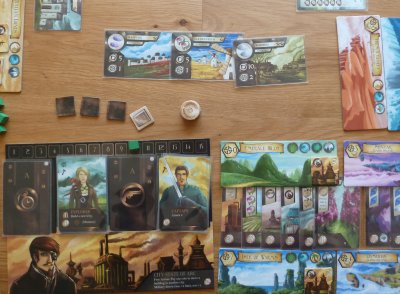

![[IMAGE]](../bilder/coiron1.jpg) |
Author: Publisher: No. of Players: Awards: |
![[IMAGE]](../technik/box/rot/rot-6.gif) ![[IMAGE]](../technik/box/gelb/gelb-10.gif) ![[IMAGE]](../technik/box/grun/grun-6.gif) ![[IMAGE]](../technik/box/pink/pink-9.gif) ![[IMAGE]](../technik/box/blau/blau-10.gif) |
|
In 2012 newcomer author Ryan Laukat released his first boardgame Empires of the Void under the label of his own publishing house RED RAVEN, and apart from the rather beautiful artwork which Ryan created himself the game showed some rather promising approaches because it tried to tackle the well-known topic of space opera boardgames from a new angle. So far many games of this type are time consuming behemoths, but Ryan had found some interesting mechanics to give the average playing duration of his own game a considerable decrease. Shortly after this succesful debut, Ryan announced that he would be starting to work on another big game, and so the last few months passed with eager anticipation what kind of game Ryan would create this time. When the game finally was announced on Kickstarter, I joined the ranks of the backers, and in spring 2013 I finally received a parcel containing a copy of this new game
>The new game City of Iron is set before a Steampunk-background, with the players taking control of small city-states which are trying to enlarge their sphere of influence by trade and conquest. However, before getting even a first glimpse on the mechanics of the game, the first sight of the gamebox and the playing components will attract the interest of many a gamer, since once again Ryan has outdone himself with the graphic design of the game. Ryan's history as an artist is longer than his career as a game designer, and he has created some cards for trading card games like the Adventurer-card for Dominion. However, for his own games Ryan is doing all of the artwork, and so he has equipped City of Iron with a rather lavish set of graphics which makes the game stand apart from many other products on the market.
However, after this initial praise for the great look of the components, let's now turn to the "meaty" part - the game's mechanics. City of Iron initially operates on a deckbuilding engine, with the players purchasing new cards in order to increase their possible range of actions. However, several elements differ considerably from other deckbuilding games, and these differences start with the fact that each player does not build just one deck but actually two. So, each player possesses a Civil deck which will contain cards for building, trade and exploration, whereas a player's Military deck contains cards mainly for conquest. Due to different uses of each card there is some partial overlap between both decks, but each new card which a player adds to either deck during the course of the game will be unique and a bit different from all other cards in the deck. For this reason each player possesses an identical stock of civil and military cards available for purchase, and it will be up to the players which of these cards they will purchase to enhance their decks.
 Another big difference to the "classic" deckbuilding mechanism can be seen in the fact that the decks are not shuffled upon their exhaustion. Instead, the player takes the appropriate stack of discards and turns it around to form a new deck for drawing. This gives the players a much higher control of the efficiency of their decks, since the order in which cards are used and discarded now will determine the order in which the cards will get back into the player's hand. This can result in some rather useful strategic moves, but in order to prevent the game from becoming an arduous memory exercise the players actually are allowed to check through their decks and discards any time they desire - so there is no need to memorize the order of the cards. Rather interesting is also the mechanism which Ryan has found for allowing card combinations. The players do not just determine the order in which they use their cards, but furthermore the use of the cards' abilities often requires additional "booster" symbols to power them up. These "booster" symbols in form of a hammer and a compass rose can be found in different combinations on all cards in the player's decks, and so it will be up to the players to decide which cards on their hand they are going to use for their abilities, and which cards then will be discarded for their hammer and compass rose symbols in order to "fuel" the choosen abilities. This is always a tough choice, because the players usually would love to use the abilities of each card on their hand instead of simply discarding them to fuel other cards' actions.  However, let's return once more to the rest of the playing mechanism. Each round of play the players will be allowed to perform three actions, with some of the actions like building being always available, whereas the availability of other actions depends on the Civil and Military cards on the player's hand. The aforementioned action of building is rather popular, and it stands for the players buying new building cards which are available from a common display of buildings which changes from round to round. Many of these buildings are used to increase a player's production of different kinds of trade goods, but these goods will not be physically available but instead the production capacities of each player for each kind of goods simply are recorded on the huge gameboard which shows scales for every kind of goods. When a round is over, each kind of trade goods will be evaluated, and the player producing most of a kind will gain some money, whereas the other producers of that good will go empty handed. In addition, the leadership in different kinds of trade goods is one of the key factors to win the game, since the deck of building cards which is used to feed the display of available buildings contains three cards which announce a scoring. When such a card comes up, the current round is played to its end, and afterwards the leading players for each kind of trade goods will not only receive money, but they will also be assigned victory points. However, the players do not only need money to erect new buildings, but for the more advanced (and thus more valuable) buildings they will also need to pay Science tokens. These Science tokens may be gained by the use of some of the player's cards, but they may also be gained if a player decides to erect an academy building. However, each new building acquired needs a building slot in the player's city, and at the beginning each player only can build a maximum of five different buildings in his city. There are different ways for the players to tackle this problem, and one is by the acquisition and use of the "Mayor" civil card. This card allows a player to add a district to his city, giving him some more building slots. Another, more costly, alternative is the use of the "Explorer" civil card. If equipped with a fitting vessel and fueled with enough compass rose symbols from additional cards, the explorer can reach far away countries where the players can build new cities. These cities have slightly more building slots than districts, and in addition valuable bonus-points will be earned in the end of game scoring by the most efficient explorer. Choosing the right approach is a matter of timing, and of course it's all part of the players' decisions how to compose their decks of Civil and Military cards. Talking about Military cards: These cards have military strength values, and if used together with some compass rose symbols from other cards these cards can be used for the conquest of some smaller towns which are also available from a common display. These towns will increase their owner's production capabilities for different kinds of goods, or - if you are lucky to own the Kickstarter edition of City of Iron which includes additional towns - the towns also may provide some other useful in-game abilities. However, the conquest of towns is not without risk, because towns owned by a player actually can be chosen as a target for another player's attack. This way the towns actually may change ownership in the middle of the game, and this may result in considerable changes of the positioning of each player. The conquest of a different player's town also is the most direct form of player interaction which can be found in City of Iron, but there are also many other - more subtle - occasions in which the players need to interact. So, the players compete for the best buildings available each round, and they will also need to keep a constant eye on the current levels of all competitors on the trade goods scales on the main gameboard. Likewise, the players will try to analyze the Civil and Military cards purchased by their competitors in order to guess what the others might be up to, and all this contributes to a rather enjoyable, highly interactive contest. Many other yet unmentioned aspects of the game are finely interwoven with the core rules presented above, and some examples here are the fact that the number of cards which each player may draw from his decks for the upcoming round depends on the number of districts/cities owned by the player plus the ownership of some special buildings which provide additional card draws. Another example are the already mentioned Science tokens, since these tokens are not only necessary for the purchase of some buildings, but also some of the more sophisticated Civil and Military cards are listing Science tokens as part of their purchase price. As a body, these rules work perfectly together, and it becomes clear that Ryan has spent a high degree of care to finetune City of Iron. All in all, the rather unusual approach to deckbuilding gives the game's main mechanism a unique feel and - even better - it kindles a strong wish for the players to play more and more games of City of Iron in order to try different combinations and build even better decks. This rather high addictiveness is facilitated by a comparatively low playing duration, and so the complete game with two to four players usually can be finished within a frame of about two hours. This is rather astonishing for such a multi-facetted game which satisfies even serious hobbyists' demands of real decision making, but it certainly is a proof of the modernity and elegance of Ryan's design, since the current trend in boardgaming leads away from time-consuming monster-games. | ||
|
| ||

|
|

|
|
| ||
|
Impressum / Contact Info / Disclaimer Kulkmann@aol.com
Copyright © 2013 Frank Schulte-Kulkmann, Essen, Germany | ||